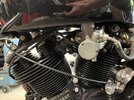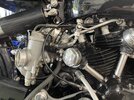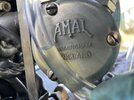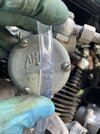I'm going to go out on a limb and speculate you have your fuel level a little too high. Normally, the fuel level should be even with the tit you see on your float bowl cover just under the "feet" of the 'MA' in 'AMAL', and is shown by the 'x' in the following diagram.
However, your carburetor is mounted at an angle of ~10°, so the level would be as shown in the next diagram.
As can be seen, if you set the level using the tit, it will be close to the metering end of the pilot screw. However, as the green line in the next diagram shows, if you set the fuel level a little too high it would be nearly past the metering end.
Stopping suddenly would push fuel to the front of the float chamber, temporarily raising level at the engine side of the chamber to where a puddle could form in the chamber above the needle. If this is the case, the mixture no longer would be metered and thus the idle mixture would be enriched.
In normal operation a difference in air pressure slowly "sucks" fuel past the end of the needle, but a rapid stop would force the fuel past the needle faster than an air pressure difference would. If your idle is set at 600 rpm = 10 revolutions/sec., each cylinder takes in a tiny amount of fuel five times/sec., so not much fuel has to be in that chamber for the idle mixture to stay excessively rich for the few seconds it takes to kill the engine.
But, as I said, this is speculation based on a fragment of information, so it could be completely wrong in your case.




